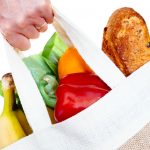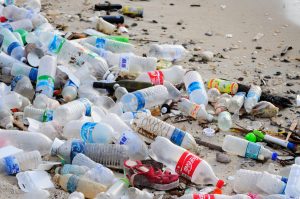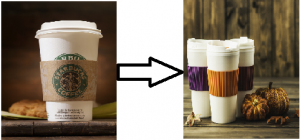5 Top Tips for Reducing Plastic Pollution.
At present it seems impossible to avoid plastic completely. However, there are ways in which you can limit your exposure. The UK government are aiming for all plastic to be either reusable or recyclable by 2042 – That’s 24 years from now! – Here are five top tips to start the reduction of plastic pollution now.

1. Why not return back to traditional shopping methods? Only a third of consumer goods currently get recycled, leading to tonnes of plastic floating in our oceans, washing up on our beaches and even entering our food chain. That’s correct, when you eat seafood your also eating tiny pieces of plastic. The largest amount of single-use plastic waste comes from the grocery sector. When it comes to ticking off the items on your shopping list why not grab alternatives to the more ‘convenient’ items that you would normally choose. Instead of buying pre-packed fruit and veg, why not buy loose fruit and veg avoiding unnecessary plastic. Other items that are available in alternative packaging include but are not limited to milk, juices, eggs and washing powder. You could purchase soap bars instead of buying the liquid soap in plastic containers. There’s no need for old fashioned soap bars, Lush Cosmetics sell handmade soaps with natural ingredients in all sorts of fancy fragrances.
2. A large portion of supermarket plastics, especially black plastic and protective film is not currently recycled because the recycling technology cannot pick it out against the black conveyer belt. This is also the case with most coloured plastic such as green bottles and milk bottles. Recycling technology struggles to recycle plastic milk bottles because of the different coloured lids that indicate the different varieties of milk. It is impossible to avoid all plastic when shopping at a supermarket. When offered a variety of the same product you can check to see if the plastic packaging it comes in is recyclable and opt for that product ensuring that when you are finished with the product the packaging is correctly recycled.
3. Before your weekly venture to the supermarket the first thing to remember are your reusable shopping bags. Since the tax on plastic bags was introduced in 2015 it has seen the usage of them decrease by 85%. This means that since 2014 their appearance on beaches has gone down by 40%. You could even invest in the canvas ones – They are available in prettier designs and will last longer !
 4. When it comes to single-use items, as the name suggests they are used once, thrown away and forgotten about. However, they are readily abundant for all to see on our beaches and in the ocean due to our ignorance when it comes to purchasing single-use items. It is estimated that by 2050 the ocean will contain more plastic by weight than fish.
4. When it comes to single-use items, as the name suggests they are used once, thrown away and forgotten about. However, they are readily abundant for all to see on our beaches and in the ocean due to our ignorance when it comes to purchasing single-use items. It is estimated that by 2050 the ocean will contain more plastic by weight than fish.
The biggest single-use problem is plastic bottles. Since last year there has been a surge in the amount of plastic bottles. Most plastic bottles that are used for water are made from a highly recyclable material. Even if once you have finished with the plastic bottle you recycle it, due to the sudden rise in the amount of plastic bottles the recycling companies are struggling to keep up. Fortunately there is a way in which you can keep hydrated without purchasing those pesky plastic bottles. Whenever you leave the house remember to take your refillable water bottle. It’s starting to become easier to get access to water when out and about with shops, cafes and businesses offering free water refill stations in the major towns and cities across the UK.
5. During early morning commutes to work when it’s cold and miserable sometimes all you need is a nice warm hot drink, so you grab a takeaway one for the journey. If you needed any other reason to purchase a hot drink then most cafes now offer a discount for customers who bring in their own reusable coffee cup. Here at Staffs Uni the Costa franchises offer a 10p discount when you bring your own cup. To help minimise waste Starbucks are starting a trial in which a 5p charge has been added to takeaway drinks. Therefore, if your wanting to save a few pennies whilst also helping the environment then why not add a reusable coffee cup to your bag.
Chelsie Maxwell (Chelsie.Maxwell@staffs.ac.uk)



 session by asking the question of whether there is a solution to this global environmental problem. He started by explaining the extent of the problem, that plastic is the predominant type of litter found globally which means that it is almost impossible to walk along a shoreline without stumbling across litter. He stated that there isn’t just one solution there are many to help the fight against plastic pollution. We need to keep gathering evidence and start making good progress towards solutions. Plastics as materials are not the cause of the problem because they bring benefits since they are lightweight, durable, inexpensive and help to reduce food waste. What we need to focus on is balancing the benefits with the environmental harm by simply doing things differently. The starting point to tackle marine litter would be single use items. We need to design products for life and end-of-life to minimise accumulation of plastic waste. Richard ended his presentation by warning that unless we change our ways it may become an even bigger problem.
session by asking the question of whether there is a solution to this global environmental problem. He started by explaining the extent of the problem, that plastic is the predominant type of litter found globally which means that it is almost impossible to walk along a shoreline without stumbling across litter. He stated that there isn’t just one solution there are many to help the fight against plastic pollution. We need to keep gathering evidence and start making good progress towards solutions. Plastics as materials are not the cause of the problem because they bring benefits since they are lightweight, durable, inexpensive and help to reduce food waste. What we need to focus on is balancing the benefits with the environmental harm by simply doing things differently. The starting point to tackle marine litter would be single use items. We need to design products for life and end-of-life to minimise accumulation of plastic waste. Richard ended his presentation by warning that unless we change our ways it may become an even bigger problem. Before a quick coffee break Professor Tamara Galloway from Exeter University explained bioaccumulation and biological effects of micro and nano plastics. The average person consumes 11,000 particles per year from seafood, but we have no idea if it causes any harm to our health. When studying plankton, it was found that the more microplastic that was added to the culture then the less algae they would feed on. This reduced fecundity after 10 days, changes faecal pellets altering the carbon cycle in the ocean and transported contaminants to the ocean floor. . When focusing on microplastics we are underestimating the number of particles that can be found as when a smaller net is used more plastic particles (nano plastics) are found. From a study using oysters, at 3 days old they preferred the nano plastics but once they reached 24 days old their habits had changed. This makes us unaware of what animals are at risk to different shapes and sizes of microplastics. It was found that the nano plastics were moving from the gut into the tissues because they were being processed differently.
Before a quick coffee break Professor Tamara Galloway from Exeter University explained bioaccumulation and biological effects of micro and nano plastics. The average person consumes 11,000 particles per year from seafood, but we have no idea if it causes any harm to our health. When studying plankton, it was found that the more microplastic that was added to the culture then the less algae they would feed on. This reduced fecundity after 10 days, changes faecal pellets altering the carbon cycle in the ocean and transported contaminants to the ocean floor. . When focusing on microplastics we are underestimating the number of particles that can be found as when a smaller net is used more plastic particles (nano plastics) are found. From a study using oysters, at 3 days old they preferred the nano plastics but once they reached 24 days old their habits had changed. This makes us unaware of what animals are at risk to different shapes and sizes of microplastics. It was found that the nano plastics were moving from the gut into the tissues because they were being processed differently.
 The afternoon session consisted of an open panel discussion on science policy challenges in polar conservation and management. This is part of the workshop series from the British Antarctic Survey and Cambridge Conservation Initiative. It was designed to discuss key topics with experts working in different regions and disciplines. Things discussed was the need to transform the linear system to a circular system. How more bans or taxes should be introduced as from previous ones it is clear that they are making a difference. The need for ideas on how to fix the problem rather than move away from plastic and ensuring that global, national and corporate are aligning in the same direction. The concluding statement was that due to a surge in interest it is important that we don’t waste this opportunity to make a change. Unless we work together to identify paths to go down and the quickest way to solve the problem as this opportunity could be wasted.
The afternoon session consisted of an open panel discussion on science policy challenges in polar conservation and management. This is part of the workshop series from the British Antarctic Survey and Cambridge Conservation Initiative. It was designed to discuss key topics with experts working in different regions and disciplines. Things discussed was the need to transform the linear system to a circular system. How more bans or taxes should be introduced as from previous ones it is clear that they are making a difference. The need for ideas on how to fix the problem rather than move away from plastic and ensuring that global, national and corporate are aligning in the same direction. The concluding statement was that due to a surge in interest it is important that we don’t waste this opportunity to make a change. Unless we work together to identify paths to go down and the quickest way to solve the problem as this opportunity could be wasted.












